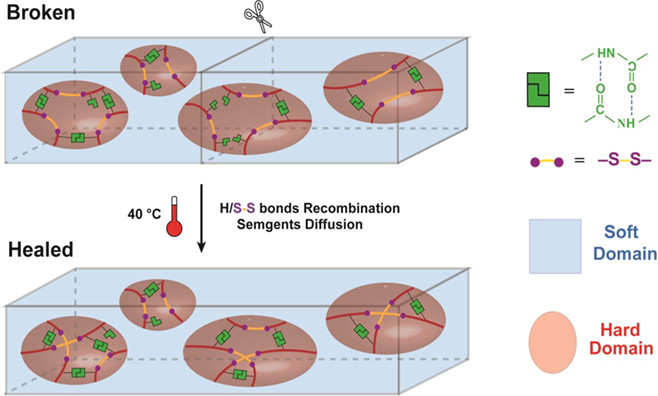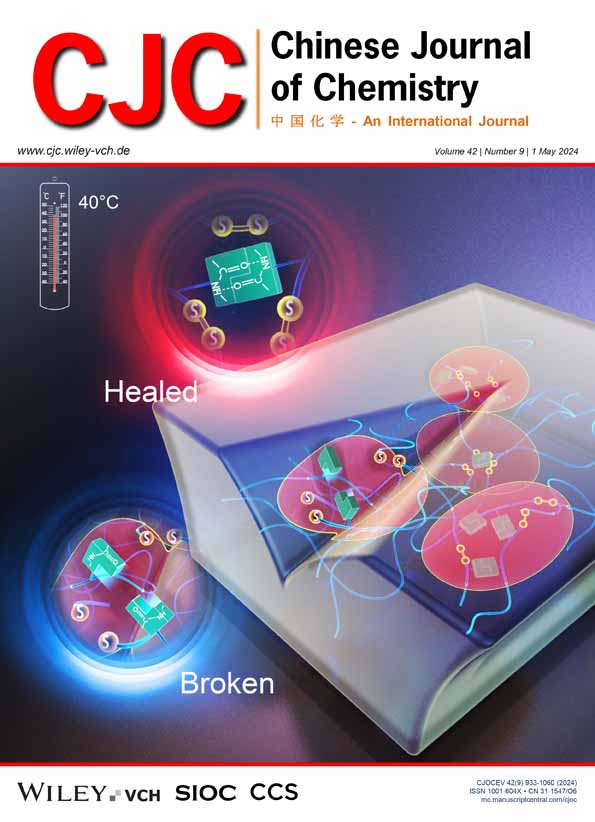A Disulfide-Based Poly(ether-b-amide) Copolymer with Rapid Self-healing Ability under Moderate Conditions†
Weijian Lu
Institute of Chemistry, Chinese Academy of Sciences, Beijing, 100190 China
School of Chemical Sciences, University of Chinese Academy of Sciences, Beijing, 100049 China
Search for more papers by this authorPing Zhu
Institute of Chemistry, Chinese Academy of Sciences, Beijing, 100190 China
Search for more papers by this authorYing Zhao
Institute of Chemistry, Chinese Academy of Sciences, Beijing, 100190 China
Search for more papers by this authorDujin Wang
Institute of Chemistry, Chinese Academy of Sciences, Beijing, 100190 China
School of Chemical Sciences, University of Chinese Academy of Sciences, Beijing, 100049 China
Search for more papers by this authorCorresponding Author
Xia Dong
Institute of Chemistry, Chinese Academy of Sciences, Beijing, 100190 China
School of Chemical Sciences, University of Chinese Academy of Sciences, Beijing, 100049 China
E-mail: [email protected]Search for more papers by this authorWeijian Lu
Institute of Chemistry, Chinese Academy of Sciences, Beijing, 100190 China
School of Chemical Sciences, University of Chinese Academy of Sciences, Beijing, 100049 China
Search for more papers by this authorPing Zhu
Institute of Chemistry, Chinese Academy of Sciences, Beijing, 100190 China
Search for more papers by this authorYing Zhao
Institute of Chemistry, Chinese Academy of Sciences, Beijing, 100190 China
Search for more papers by this authorDujin Wang
Institute of Chemistry, Chinese Academy of Sciences, Beijing, 100190 China
School of Chemical Sciences, University of Chinese Academy of Sciences, Beijing, 100049 China
Search for more papers by this authorCorresponding Author
Xia Dong
Institute of Chemistry, Chinese Academy of Sciences, Beijing, 100190 China
School of Chemical Sciences, University of Chinese Academy of Sciences, Beijing, 100049 China
E-mail: [email protected]Search for more papers by this authorDedicated to the Special Issue of Emerging Themes in Polymer Science.
Comprehensive Summary
A disulfide-based poly(ether-b-amide) copolymer with rapid self-healing capability under moderate conditions was synthesized from 4,4’-dithiodibutyric acid (DTDBA), isophorondiamine (IPDA) and poly(tetramethylene oxide) (PTMO) based on a two-step method. The incorporation of IPDA with asymmetric structure and substantial steric hindrance not only effectively decreased the number of regular H-bonds, but also inhibited the crystallization of polyamide segments, imparting the synthesized poly(ether-b-amide) copolymer with an amorphous structural feature. Based on the coordination of segmental diffusion and recombination of disulfide bonds and hydrogen bonds, the scratches and damaged mechanical properties of PEBADS-I611 could be completely self-healed after healing at 40 °C for only 11 min and 3 h, respectively.
Supporting Information
| Filename | Description |
|---|---|
| cjoc202300603-sup-0001-supinfo.pdfPDF document, 1,018.7 KB |
Appendix S1: Supporting Information |
Please note: The publisher is not responsible for the content or functionality of any supporting information supplied by the authors. Any queries (other than missing content) should be directed to the corresponding author for the article.
References
- 1 Buckwalter, D. J.; Dennis, J. M.; Long, T. E. Amide-containing segmented copolymers. Prog. Polym. Sci. 2015, 45, 1–22.
- 2 Sheth, J. P.; Xu, J. N.; Wilkes, G. L. Solid state structure-property behavior of semicrystalline poly(ether-block-amide) pebax thermoplastic elastomers. Polymer 2003, 44, 743–756.
- 3 Gong, S.; Zhao, S. K.; Chen, X. Y.; Liu, H. P.; Deng, J. P.; Li, S. Y.; Feng, X. X.; Li, Y. C.; Wu, X.; Pan, K. Thermoplastic polyamide elastomers: synthesis, structure/properties, and applications. Macromol. Mater. Eng. 2021, 306, 2100568.
- 4 Wang, Y.; Shao, J. M.; Zhu, P.; Wang, L.; Wang, D. J.; Dong, X. Brill transition in polyamide 1012 multiblock poly(tetramethylene oxide) copolymers: the effect of composition on hydrogen bonding organization. Macromolecules 2022, 55, 7683–7694.
- 5 Jiang, L.; Kong, W. B.; Wu, B.; Fu, X. W.; Xiao, Y.; Zhou, C. L. Reactive processing of thermoplastic elastomers based on polyamide-6: preparation and characterization. J. Appl. Polym. Sci. 2017, 134, 45353.
- 6 Van der Schuur, M.; Gaymans, R. Influence of morphology on the properties of segmented block copolymers. Polymer 2007, 48, 1998–2006.
- 7 Han, R. Z.; Campbell, K. P. Dysferlin and muscle membrane repair. Curr. Opin. Cell Biol. 2007, 19, 409–416.
- 8 Diegelmann R.; Evans, M. C. Wound healing: an overview of acute, fibrotic and delayed healing. Front. Biosci. 2004, 9, 283–289.
- 9 Paris, R.; Lamattina, L.; Casalongue, C. A. Nitric oxide promotes the wound-healing response of potato leaflets. Plant Physiol. Biochem. 2007, 45, 80–86.
- 10 Patrick, J. F.; Robb, M. J.; Sottos, N. R.; Moore, J. S.; White, S. R. Polymers with autonomous life-cycle control. Nature 2016, 540, 363–370.
- 11 Chen, X. X.; Dam, M. A.; Ono, K. J.; Mal, A.; Shen, H. B.; Nutt, S. R.; Sheran, K.; Wudl, F. A thermally re-mendable cross-linked polymeric material. Science 2002, 295, 1698–1702.
- 12 Canadell, J.; Goossens, H.; Klumperman, B. Self-healing materials based on disulfide links. Macromolecules 2011, 44, 2536–2541.
- 13 Michal, B. T.; Jaye, C. A.; Spencer, E. J.; Rowan, S. J. Inherently photohealable and thermal shape-memory polydisulfide networks. ACS Macro Lett. 2013, 2, 694–699.
- 14 Lei, Z. Q.; Xiang, H. P.; Yuan, Y. J.; Rong, M. Z.; Zhang, M. Z.; Zhang, M. Q. Room-temperature self-healable and remoldable cross-linked polymer based on the dynamic exchange of disulfide bonds. Chem. Mater. 2014, 26, 2038–2046.
- 15 Kim, S. M.; Jeon, H.; Shin, S. H.; Park, S. A.; Jegal, J.; Hwang, S. Y.; Oh, D. X.; Park, J. Superior toughness and fast self-healing at room temperature engineered by transparent elastomers. Adv. Mater. 2018, 30, 1705145.
- 16 Ji, S. B.; Cao, W.; Yu, Y.; Xu, H. P. Visible-light-induced self-healing diselenide-containing polyurethane elastomer. Adv. Mater. 2015, 27, 7740–7745.
- 17 Xia, J. H.; Li, T. Y.; Lu, C. J.; Xu, H. P. Selenium-containing polymers: perspectives toward diverse applications in both adaptive and biomedical materials. Macromolecules 2018, 51, 7435–7455.
- 18 Xia, J. H.; Tan, Y. Z.; Xu, H. P. Selenium-containing dynamic covalent polymers. Acta Polym. Sin. 2020, 51, 1190–1200.
- 19 Zhang, Y. L.; Tao, L.; Li, S. X.; Wei, Y. Synthesis of multiresponsive and dynamic chitosan-based hydrogels for controlled release of bioactive molecules. Biomacromolecules 2011, 12, 2894–2901.
- 20 Kovaricek, P.; Lehn, J. M. Merging constitution and motional covalent dynamics in reversible imine formation and exchange processes. J. Am. Chem. Soc. 2012, 134, 9446–9455.
- 21 Taynton, P.; Yu, K.; Shoemaker, R. K.; Jin, Y. H.; Qi, H. J.; Zhang, W. Heat- or water-driven malleability in a highly recyclable covalent network polymer. Adv. Mater. 2014, 26, 3938–3942.
- 22 Deng, G. H.; Tang, C. M.; Li, F. Y.; Jiang, H. F.; Chen, Y. M. Covalent cross-linked polymer gels with reversible sol-gel transition and self-healing properties. Macromolecules 2010, 43, 1191–1194.
- 23 Cordier, P.; Tournihac, F.; Soulie-Ziakovic, C.; Leibler, L. Self-healing and thermoreversible rubber from supramolecular assembly. Nature 2008, 451, 977–980.
- 24 Qin, B.; Zhang, S.; Sun, P.; Tang, B. H.; Yin, Z. H.; Cao, X.; Chen, Q.; Xu, J. F.; Zhang, X. Tough and multi-recyclable cross-linked supramolecular polyureas via incorporating noncovalent bonds into main-chains. Adv. Mater. 2020, 32, 2000096.
- 25 Li, Z. Q.; Zhu, Y. L.; Niu, W. W.; Yang, X.; Jiang, Z. H.; Lu, Z. Y.; Liu, X. K.; Sun, J. Q. Healable and recyclable elastomers with record-high mechanical robustness, unprecedented crack tolerance, and superhigh elastic restorability. Adv. Mater. 2021, 33, 2101498.
- 26 Wang, Q. G.; Mynar, J. L.; Yoshida, M.; Lee, E.; Lee, M.; Okuro, K.; Kinbara, K.; Aida, T. High-water-content mouldable hydrogels by mixing clay and a dendritic molecular binder. Nature 2010, 463, 339–343.
- 27 Burnworth, M.; Tang, L. M.; Kumpfer, J. R.; Duncan, A. J.; Beyer, F. L.; Fiore, G. L.; Rowan, S. J.; Weder, C. Optically healable supramolecular polymers. Nature 2011, 472, 334–337.
- 28 Li, C. H.; Wang, C.; Keplinger, C.; Zuo, J. L.; Jin, L. H.; Sun, Y.; Zheng, P.; Cao, Y.; Lissel, F.; Linder, C.; You, X. Z.; Bao, Z. N. A highly stretchable autonomous self-healing elastomer. Nat. Chem. 2016, 8, 619–625.
- 29 Lai, J. C.; Jia, X. Y.; Wang, D. P.; Deng, Y. B.; Zheng, P.; Li, C. H.; Zuo, J. L.; Bao, Z. N. Thermodynamically stable whilst kinetically labile coordination bonds lead to strong and tough self-healing polymers. Nat. Commun. 2019, 10, 1164.
- 30 Shao, J. M.; Dong, X.; Wang, D. J. Stretchable Self-Healing Plastic Polyurethane with Super-High Modulus by Local Phase-Lock Strategy. Macromol. Rapid Commun. 2023, 44, 2200.
- 31 Shao, J. M.; Wang, Y.; Zhu, P.; Dong, X.; Wang, D. J. Robust polyurethane materials with synergistic ionic and metal-ligand crosslinking double networks for specific Cu-ion removal. Chem. Eng. J. 2023, 474, 145719.
- 32 Weng, W. G.; Li, Z.; Jamieson, A. M.; Rowan, S. J. Effect of monomer structure on the gelation of a class of metallo-supramolecular polymers. Soft Matter 2009, 5, 4647–4657.
- 33 Lai, Y.; Kuang, X.; Yang, W. H.; Wang, Y.; Zhu, P.; Li, J. P.; Dong, X.; Wang, D. J. Dynamic bonds mediate π-π interaction via phase locking effect for enhanced heat resistant thermoplastic polyurethane. Chin. J. Polym. Sci. 2021, 39, 154–163.
- 34 Nakahata, M.; Takashima, Y.; Harada, A. Highly flexible, tough, and self-healing supramolecular polymeric materials using host-guest interaction. Macromol. Rapid Commun. 2016, 37, 96–92.
- 35 Wu, J. R.; Cai, L. H.; Weitz, D. A. Tough self-healing elastomers by molecular enforced integration of covalent and reversible networks. Adv. Mater. 2017, 29, 1702616.
- 36 Nurhamiyah, Y.; Amir, A.; Finnegan, M.; Themistou, E.; Edirisinghe, M.; Chen, B. Q. Wholly biobased, highly stretchable, hydrophobic, and self-healing thermoplastic elastomer. ACS Appl. Mater. Interfaces 2021, 13, 6720–6730.
- 37 Chen, Z. Q.; Ma, H. R.; Li, Y. X.; Meng, J. J.; Yao, Y. W.; Yao, C. Biomass polyamide elastomers based on hydrogen bonds with rapid self- healing properties. Eur. Polym. J. 2020, 133, 109802.
- 38 Chen, Z. X.; Li, Y. X.; Yao, C. Biomass shape memory elastomers with rapid self-healing properties and high recyclability. Biomacromolecules 2021, 22, 2768–2776.
- 39 Wu, M.; Yuan, L.; Jiang, F.; Zhang, Y. Q.; He, Y. R.; You, Y. Z.; Tang, C. B.; Wang, Z. K. Strong autonomic self-healing biobased polyamide elastomers. Chem. Mater. 2020, 32, 8325–8332.
- 40 Lu, W. J.; Zhu, P.; Zhao, Y.; Wang, D. J.; Dong, X. A transparent, healable and recyclable alicyclic poly(ether-b-amide) multiblock copolymer with ultrahigh toughness. Chem. Eur. J. 2023, e202300622.
- 41 Xu, L. Y.; Shi, W. The effect of composition of polyamide-polyether multiblock copolymers on crystallization behavior. Polym. Mater. Sci. Eng. 1990, 6, 25–25.
- 42
Cao, Y. Y.; Zhu, P.; Wang, Z. F.; Zhou, Y.; Chen, H. M.; Muller, A. J.; Wang, D. J.; Dong, X. Influence of soft block crystallization on microstructural variation of double crystalline poly(ether-mb-amide) multiblock copolymers. Polym. Crystallization 2018, 1, e10012.
10.1002/pcr2.10012 Google Scholar
- 43 Lai, Y.; Kuang, X.; Zhu, P.; Huang, M. M.; Dong, X.; Wang, D. J. Colorless transparent, robust and fast scratch self-healing elastomers via phase locked dynamic bonds design. Adv. Mater. 2018, 30, 1802556.
- 44 Wen, L.; Zhang, J. H.; Zhou, T.; Zhang, A. M. Hydrogen bonding in micro-phase separation of poly(polyamide 12-block-polytetrahydrofuran) alternating block copolymer: enthalpies and molecular movements. Vib. Spectrosc. 2016, 86, 160–172.
- 45 Li, N. Study on High Energy Propellant Based on Energetic Thermoplastic Elastomers. Ph.D. Dissertation, Nanjing University of Science & Technology, Nanjing, 2013 (in Chinese).
- 46 Luo, Y. J.; Ding, S. J.; Zhang, C. Research Progress on Energetic Thermoplastic Elastomers. Mater. China 2022, 41, 117–128.




